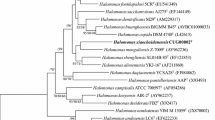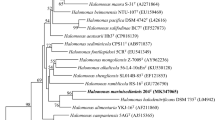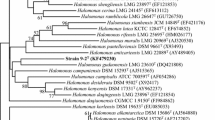Abstract
In the course of the search for N2O-utilizing microorganisms, two novel strains of haloalkaliphilic denitrifying bacteria, Z-7009 and AIR-2, were isolated from soda lakes of Mongolia and Kenya. These microorganisms are true alkaliphiles and grow in the pH ranges of 8.0–10.5 and 7.5–10.6, respectively. They are facultative anaerobes with an oxidative type of metabolism, able to utilize a wide range of organic substrates and reduce nitrate, nitrous oxide, and, to a lesser extent, nitrite to gaseous nitrogen. They can oxidize sulfide in the presence of acetate as the carbon source and nitrous oxide (strain Z-7009) or nitrate (strain AIR-2) as the electron acceptor. The strains require Na+ ions. They grow at 0.16–2.2 M Na+ (Z-7009) and 0.04–2.2 M Na+ (AIR-2) in the medium. The G+C contents of the DNA of strains Z-7009 and AIR-2 are 67.9 and 65.5 mol %, respectively. According to the results of 16S rRNA gene sequencing and DNA-DNA hybridization, as well as on the basis of physiological properties, the strains were classified as new species of the genus Halomonas: Halomonas mongoliensis, with the type strain Z-7009T (=DSM 17332, =VKM B2353), and Halomonas kenyensis, with the type strain AIR-2T (=DSM 17331, =VKM B2354).
Similar content being viewed by others
References
Berendes, F., Gottschalk, G., Heine-Dobbernack, E., Moore, E.R.B., and Tindall, B.J., Halomonas desiderata sp. nov., a New Alkaliphilic, Halotolerant and Denitrifying Bacterium Isolated from a Municipal Sewage Works, Syst. Appl. Microbiol., 1996, vol. 19, pp. 158–167.
Mormile, M.R., Romine, M.F., Garcia, M.T., Ventosa, A., Bailey, T.J., and Peyton, B.M., Halomonas campisalis sp. nov., a Denitrifying, Moderately Haloalkaliphilic Bacterium, Syst. Appl. Microbiol., 1999, vol. 22, pp. 551–558.
Duckworth, A.W., Grant, W.D., Jones, B.E., Meijer, D., Márquez, M.C., and Ventosa, A., Halomonas magadii sp. nov., a New Member of the Genus Halomonas, Isolated from a Soda Lake of the East African Rift Valley, Extremophiles, 2000, vol. 4, pp. 53–60.
Romano, I., Giordano, A., Lama, L., Nicolaus, B., and Gambacorta, A., Halomonas campaniensis sp. nov., a Haloalkaliphilic Bacterium Isolated from a Mineral Pool of Campania Region, Italy, Syst. Appl. Microbiol., 2005, vol. 28, pp. 610–618.
Boltyanskaya, Yu.V., Antipov, A.N., Kolganova, T.V., Lysenko, A.M., Kostrikina, N.A., and Zhilina, T.N., Halomonas campisalis, an Obligatorily Alkaliphilic, Nitrous Oxide-Reducing Denitrifier with a Molybdenum Cofactor-Lacking Nitrate Reductase, Mikrobiologiya, 2004, vol. 73, pp. 326–334 [Microbiology (Engl. Transl.), vol. 73, no. 3, pp. 271–278].
Sorokin, D.Yu., Kuenen, J.G., and Jetten, M.S.M., Denitrification at Extremely High pH Values by the Alkaliphilic, Obligately Chemolithoautotrophic, Sulfur-Oxidizing Bacterium Thioalkalivibrio denitrificans Strain ALJD, Arch. Microbiol., 2001, vol. 175, pp. 94–101.
Sorokin, D.Yu., Tourova, T.P., Sjollema, K.A., and Kuenen, J.G., Thioalkalivibrio nitratireducens sp. nov., a Nitrate-Reducing Member of Autotrophic Denitrifying Consortium from a Soda Lake, Int. J. Syst. Evol. Microbiol., 2003, vol. 53, pp. 1779–1783.
Sorokin, D.Yu., Zhilina, T.N., Lysenko, A.M., Tourova, T.P., and Spiridonova, E.M., Metabolic Versatility of Haloalkaliphilic Bacteria from Soda Lakes Belonging to the Alkalispirillum-Alkalilimnicola Group, Extremophiles, 2006, vol. 10, pp. 213–220.
Sorokin, D.Yu., Gorlenko, V.M., Namsaraev, B.B., Namsaraev, Z.B., Lysenko, A.M., Eshinimaev, B.Ts., Khmelenina, V.N., Trotsenko, Yu.A., and Kuenen, J.G., Prokaryotic Communities of the North-Eastern Mongolian Soda Lakes, Hydrobiologia, 2004, vol. 522, pp. 235–248.
Martínez-Cánovas, M.J., Quesada, E., Llamas, I., and Béjar, V., Halomonas ventosae sp. nov., a Moderately Halophilic, Denitrifying, Exopolysaccharide-Producing Bacterium, Int. J. Syst. Evol. Microbiol., 2004, vol. 54, pp. 733–737.
Yoon, J.-H., Lee, K.-C., Kho, Y.H., Kang, K.H., Kim, C.-J., and Park, Y.-H., Halomonas alimentaria sp. nov., Isolated from Jeotgal, a Traditional Korean Fermented Seafood, Int. J. Syst. Evol. Microbiol., 2002, vol. 52, pp. 123–130.
Stead, D.E., Sellwood, J.E., Wilson, J., and Viney, I., Evaluation of a Commercial Microbial Identification System Based on Fatty Acid Profiles for Rapid, Accurate Identification of Plant Pathogenic Bacteria, J. Appl. Bacteriol., 1992, vol. 72, pp. 315–321.
Tourova, T.P., Garnova, E.S., and Zhilina, T.N., Phylogenetic Diversity of Alkaliphilic Anaerobic Saccharolytic Bacteria Isolated from Soda Lakes, Mikrobiologiya, 1999, vol. 68, no. 5, pp. 701–709 [Microbiology (Engl. Transl.), vol. 68, no. 5, pp. 615–622].
De Ley, J., Cattoir, H., and Reynaerts, A., The Quantitative Measurement of DNA Hybridization from Renaturation Rates, Eur. J. Biochem., 1970, vol. 12, pp. 133–142.
Microbial Life in Extreme Environments, Kushner, D.J., Ed., London: Academic, 1978. Translated under the title Zhizn’ mikrobov v ekstremal’nykh usloviyakh, Moscow: Mir, 1981.
Oren, A., The Bioenergetic Basis for the Decrease in Metabolic Diversity at Increasing Salt Concentrations: Implications for Functioning of Salt Lake Ecosystems, Hydrobiologia, 2001, vol. 466, pp. 61–72.
Mata, J.A., Martínez-Cánovas, J., Quesada, E., and Béjar, V., A Detailed Phenotypic Characterization of the Type Strains of Halomonas Species, Syst. Appl. Microbiol., 2002, vol. 25, pp. 360–375.
Sorokin, D.Yu., Oxidation of Inorganic Sulfur Compounds by Obligately Organotrophic Bacteria, Mikrobiologiya, 2003, vol. 72, no. 6, pp. 725–739 [Microbiology (Engl. Transl.), vol. 72, no. 6, pp. 641–653].
Wayne, L.G., Brenner, D.J., Colwell, R.R., Grimont, P.A.D., Kandler, O., Krichevsky, M.I., Moore, L.H., Moore, W.E.C., Murray, R.G.E., Stackebrandt, E., Starr, M.P., and Trüwper, H.G., International Committee on Systematic Bacteriology. Report of the Ad Hoc Committee on Reconciliation of Approaches to Bacterial Systematics, Int. J. Syst. Bacteriol., 1987, vol. 37, pp. 463–464.
Reddy, G.S.N., Raghavan, P.U.M., Sarita, N.B., Prakash, J.S.S., Nagesh, N., Delille, D., and Shivaji, S., Halomonas glaciei sp. nov. Isolated from Fast Ice of Adelie Land, Antarctica, Extremophiles, 2003, vol. 7, pp. 55–61.
Author information
Authors and Affiliations
Corresponding author
Additional information
Original Russian Text © Yu.V. Boltyanskaya, V.V. Kevbrin, A.M. Lysenko, T.V. Kolganova, T.P. Tourova, G.A. Osipov, T.N. Zhilina, 2007, published in Mikrobiologiya, 2007, Vol. 76, No. 6, pp. 834–843.
Rights and permissions
About this article
Cite this article
Boltyanskaya, Y.V., Kevbrin, V.V., Lysenko, A.M. et al. Halomonas mongoliensis sp. nov. and Halomonas kenyensis sp. nov., new haloalkaliphilic denitrifiers capable of N2O reduction, isolated from soda lakes. Microbiology 76, 739–747 (2007). https://doi.org/10.1134/S0026261707060148
Received:
Issue Date:
DOI: https://doi.org/10.1134/S0026261707060148




